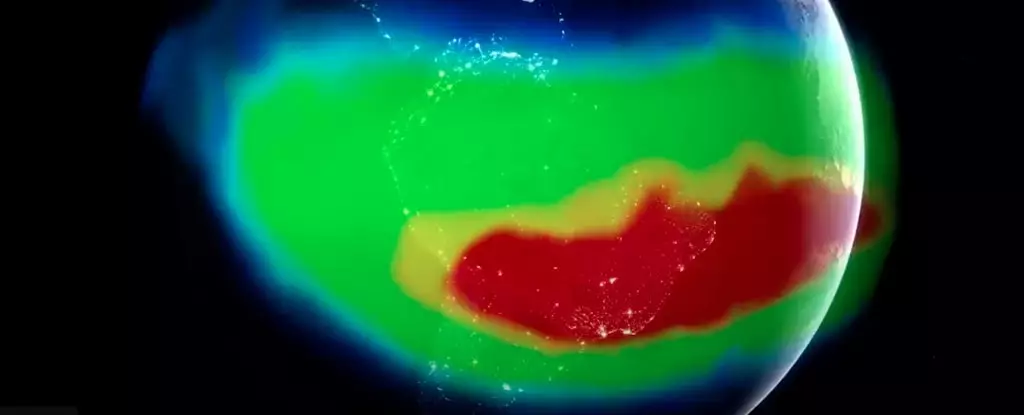Earth is enveloped in a protective magnetic field, a force that safeguards our planet from the harmful solar winds and cosmic radiation that bombard us from space. However, a peculiar phenomenon known as the South Atlantic Anomaly (SAA) has emerged, captivating researchers and igniting questions about Earth’s magnetic behavior. Spanning a massive area between South America and southwestern Africa, this anomaly represents a region of significantly reduced magnetic intensity. NASA has been closely watching this anomaly, as its weakness poses risks to various satellites and the International Space Station (ISS), which traverse this zone at low-Earth orbit altitudes.
The SAA can be likened to a “dent” in Earth’s magnetic shield, creating a localized region where magnetic forces are weaker than surrounding areas. Although this does not directly affect life on Earth’s surface, it raises considerable concerns for technology in orbit. Satellites and spacecraft can experience intermittent glitches or significant malfunctions when exposed to high-energy protons from the Sun within the SAA, compelling operators to implement precautionary measures, including temporarily shutting down sensitive systems when entering this zone.
At the heart of the SAA lies a complex interplay of geological and geophysical factors. The primary generator of Earth’s magnetic field is believed to be a swirling mass of molten iron located thousands of kilometers beneath the Earth’s surface in the outer core. These movements produce electrical currents that create the magnetic field; however, various factors disrupt and weaken its generation, resulting in the peculiar characteristics of the SAA.
Recent studies have suggested that an underlying geological feature known as the African Large Low Shear Velocity Province disrupts the magnetic field’s generation in this specific region. This vast reservoir of dense rock affects the orientations of magnetic fields, contributing to the peculiar weakening observed in the SAA. Furthermore, the tilt of the planet’s magnetic axis influences this process, adding another layer of complexity to scientists’ understanding of the anomaly.
Geophysicists from NASA have posited that this anomaly could be indicative of broader magnetic changes taking place in Earth’s core. The weakening of the dipole magnetic field in the SAA could be linked to localized fields showing reversed polarity. This dynamic could provide crucial insights into not only the SAA’s behavior but also the long-term evolution of Earth’s magnetic field.
Scientists have determined that the South Atlantic Anomaly is not static; rather, it exhibits a slow but noticeable drift. Astounding discoveries at NASA, including tracking performed by CubeSats, have illustrated that the SAA’s position around the globe is not fixed but continually shifts, which raises intriguing questions about its long-term dynamics. Moreover, evidence suggests that the SAA is in the process of bifurcating, as researchers have documented the emergence of two distinct magnetic centers within the original anomaly.
The implications of this division could alter our understanding of magnetic fields and provide valuable data for forecasting future changes. If the SAA is indeed in a transition state, the consequences for Earth’s magnetic field might be profound, although the exact significance of these changes remains poorly understood.
Interestingly, a study published in July 2020 hinted that the South Atlantic Anomaly is not a novel event but a recurring feature in Earth’s geological history, potentially present for over 11 million years. Scholars have suggested that this phenomenon may interact with long-term cycles of magnetic field reversal, although these events typically occur over extensive periods. This perspective shifts the SAA from being a mere curiosity to a critical aspect of our planet’s geomagnetic history.
As the mystery surrounding the SAA continues to unfold, it emphasizes the need for sustained vigilance and research. NASA scientists are committed to monitoring this enigmatic anomaly, believing that it serves not merely as a point of concern but as an invaluable opportunity to deepen our understanding of magnetic fields, their behavior, and their potential impacts on both technology and Earth’s geological past. The agency’s ongoing observations and missions seek to unravel the complexities of the SAA, potentially leading to groundbreaking revelations in magnetism and its implications for life on Earth.
The enigmatic South Atlantic Anomaly stands as a testament to the incompleteness of our understanding of Earth’s magnetic system. Through continued research and exploration, scientists will strive to decode its secrets, ensuring that we remain prepared to address the challenges it may pose to our technological landscape in the future.


Leave a Reply